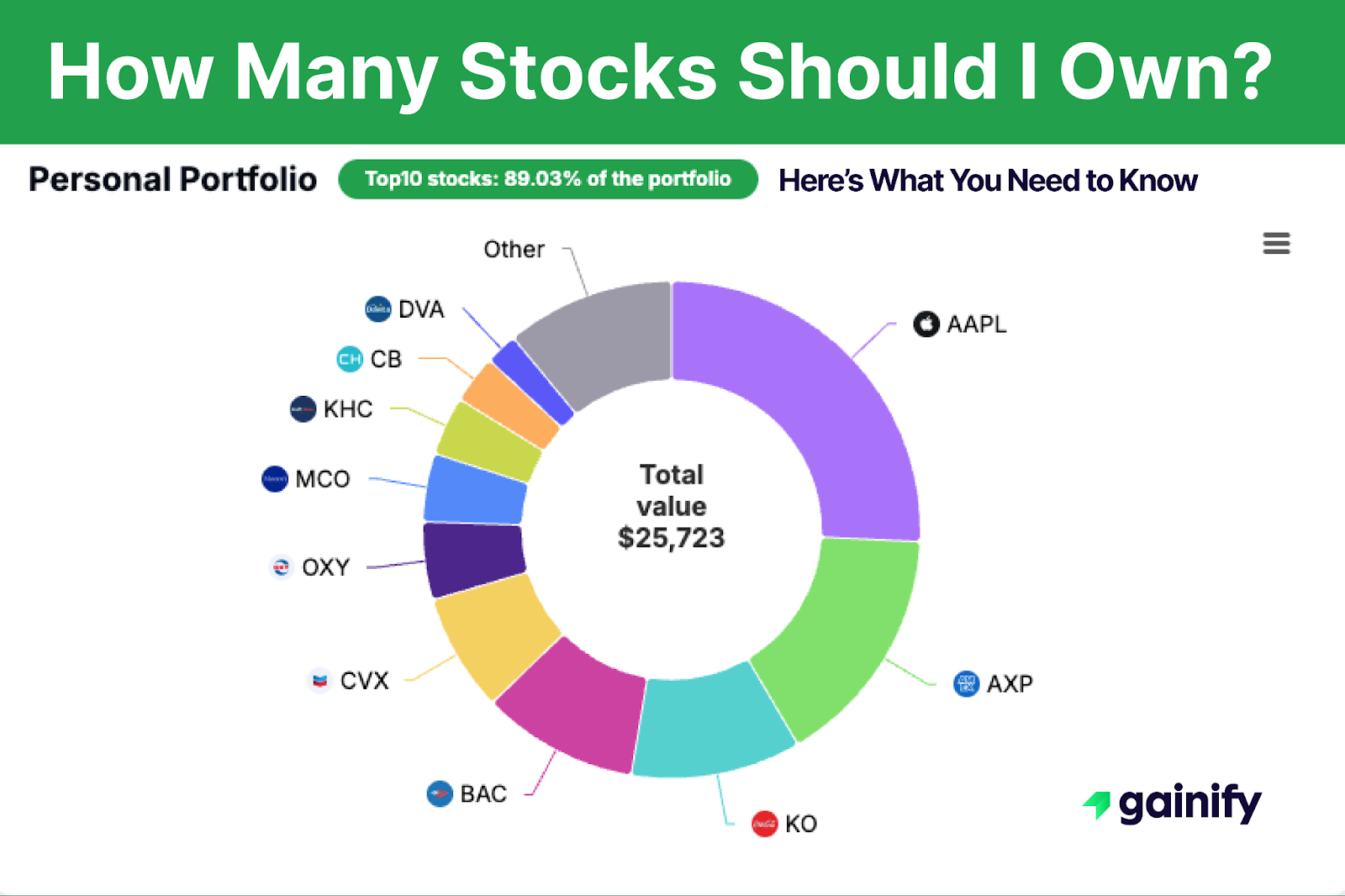“How many stocks should I own?” might seem like a simple question, but it reveals a lot about you as an investor. Your answer depends on how much risk you’re willing to take, how confident you feel in your choices, and how much time you want to spend managing your portfolio. There is no perfect number. What matters is that it fits your goals and style.
If you own too few stocks, one bad result could have a big impact. If you own too many, it can become hard to follow what’s happening. A good portfolio doesn’t need to be large. It needs to be clear. Every stock should have a reason to be there. The goal is not to collect names but to build something that makes sense to you.
Some investors focus on a few businesses they know well. Others prefer a broader mix to lower their risk. Both ways can work, as long as the structure fits how you make decisions and how you respond to change. What works for one person might not work for another.
Your portfolio should be something you can understand, monitor, and adjust when needed. If it feels too scattered, it might be time to simplify. If it feels too narrow, you may want to add more balance. The right number of stocks is not a rule. It’s a choice that depends on how you want to invest.
In this article, you’ll learn how to think about the number of stocks you should own based on your investing style, goals, and comfort with risk. We’ll walk through three common portfolio ranges, from focused to more diversified, and explain what each means in practice. Whether you’re an active investor or prefer a hands-off approach, this guide will help you shape a stock portfolio that makes sense for you. Along the way, we’ll cover what too few or too many stocks might mean, how to avoid common mistakes, and how to make smarter decisions about building a portfolio that fits your plan.
Why Portfolio Size Matters More Than You Think
Many investors believe that owning more stocks automatically leads to better results. It sounds safer. But after a certain point, more is not actually better. Once you hold more than 20 to 30 stocks, the benefit of diversification begins to flatten. The risk reduction slows down, while the complexity continues to grow.
Diversification protects you, but overdoing it can water down your best ideas.
This idea is supported by Harry Markowitz’s research in modern portfolio theory. It shows that holding a well-balanced mix of stocks across different sectors can reduce overall risk. But this does not mean you need to hold 100 or more positions. What matters more is how carefully you choose, not how many you hold.
A strong portfolio is not built by volume. It’s built by intention. Every stock should serve a purpose. If you end up owning dozens of companies without knowing why, you may unintentionally create a personal version of a mutual fund without the structure or support professionals use to manage it.
You are not collecting stocks. You are building a plan. Your portfolio should reflect your thinking, your goals, and your strategy. The size matters, but only when it supports the way you invest.
Tier 1: Up to 10 Stocks – Focused Investing with High Conviction
Holding fewer than 10 stocks is a strategy built on deep conviction and close attention. This approach is best suited for investors who know exactly what they’re buying and have a strong reason behind each choice. These portfolios often include dominant companies, aggressive growth stocks with big potential, or dividend-paying stocks you’ve studied and followed for years.
In a concentrated portfolio, every position counts. One misstep can have a noticeable impact, but the reward for being right is much higher. When your research is solid and your understanding is clear, this level of focus can lead to meaningful long-term gains through compounding.
Some of the most successful value investors have used this method to turn a few key ideas into outstanding results. It allows you to go deep instead of wide, turning insight into performance. But it comes with responsibility. This style demands the ability to stay rational when markets are volatile.
This path is not about having more control. It’s about having more clarity. It’s a style that works best for investors who want to be hands-on, think independently, and are comfortable taking on concentrated risk when the opportunity is strong.
Tier 2: 10 to 20 Stocks — The Balanced Core for Most Investors
THolding 10 to 20 stocks offers a healthy middle ground. It’s often the most practical range for individual investors who want meaningful diversification without losing track of what they own. You still have room to concentrate on your best ideas, but with enough spread to cushion against market surprises.
This range allows for both clarity and control. You can mix value stocks, high-yield names, and growth-oriented businesses across different industries. Real estate investment trusts, financials, oil companies, and e-commerce platforms can all work together in a portfolio like this without overcomplicating your strategy.
This size also fits well with most long-term investment plans and asset allocation frameworks. It gives you enough flexibility to respond to changes in the market or economy, without forcing you into constant portfolio maintenance.
For many investors, this tier is the sweet spot. It offers structure without being rigid, variety without becoming noisy, and enough focus to still make each decision count.
Tier 3: 20 to 30 Stocks — Broad Diversification With Structure
A portfolio of 20 to 30 stocks gives you space to diversify while still keeping a clear structure. This tier is often right for investors who want to explore more sectors, regions, or strategies without letting things get out of hand. You can combine growth and income, large and mid-cap stocks, and mix industry exposure in a way that still reflects your core beliefs.
This approach allows variety, but it still demands discipline. Adding more stocks should not mean relaxing your standards. Each position should still serve a purpose and support the balance of your overall portfolio.
At this size, you might include additional companies tied to trends or economic shifts, or use common stock blending strategies to manage style and risk. But if you begin adding names without knowing what role they play, your strategy can lose direction. When that happens, performance and confidence often suffer.
Diversification is useful, but clarity is what keeps your portfolio effective. Even with 30 holdings, you should know why each stock is there and be ready to act if something changes.
What Really Matters in Portfolio Design
The size of your portfolio should match how you think about investing. Whether you own 10 stocks or 25, each position should have a clear role. Adding more companies only makes sense if they improve your portfolio’s balance, risk profile, or long-term return potential.
A thoughtful portfolio reflects your habits, your knowledge, and the way you make decisions. Some investors do best with fewer holdings they know deeply. Others are more comfortable spreading their investments across different sectors or strategies. Both can work if the structure matches your style.
Every stock should earn its spot. If you don’t know why it’s there, it may not belong. This is not about following trends or mimicking well-known investors. It’s about building a portfolio that you understand and can manage with confidence.
Think of your portfolio the way you would design a home. It should have structure, stability, and a purpose behind every choice. A portfolio built that way can grow with you, adapt over time, and stay strong in any market condition.
FAQ: How Many Stocks Should I Own?
Q: Is owning 10 stocks enough for proper diversification?
Yes, it can be. If your stocks come from different sectors and have unique business models, 10 holdings may provide enough balance. The focus should be on thoughtful selection, not a specific number.
Q: What’s the advantage of owning 10 to 20 stocks?
This range offers a solid middle ground. It allows you to stay close to your investments while maintaining enough variety to reduce risk. Many investors find this to be a smart balance between control and diversification.
Q: Is more than 30 stocks too many?
Not necessarily. If each stock plays a clear role in your overall strategy, the number is not a problem. But if you’re unsure why something is in your portfolio, it might be time to simplify and refocus.
Q: How does my investment plan affect the number of stocks I should own?
Your plan guides everything. It helps you decide how diversified you need to be, how much exposure you want to different sectors, and how often you should review your portfolio. A clear plan keeps your decisions consistent.
Q: Are mutual funds a better way to diversify?
Mutual funds often include hundreds of stocks and are designed to meet broad mandates. As an individual investor, you usually don’t need that level of coverage to achieve effective diversification. A focused set of well-chosen companies often works better for personal portfolios.
Choose the Number That Matches How You Think
There is no fixed rule for how many stocks you should own. The right number reflects your mindset, your time, and your confidence in the businesses you’ve chosen. It’s about building a portfolio that fits the way you think and invest.
A strong portfolio isn’t defined by how many stocks it holds. It’s defined by how well it’s built. More stocks won’t make your investing smarter, but more clarity will. What matters most is intention, not volume.
Focus on structure, not size. Make decisions with purpose, not habit. A portfolio designed that way can adapt, stay clear through uncertainty, and grow with you over time.
That’s how investors create portfolios that are built to last.




